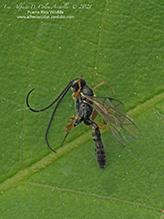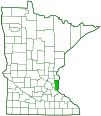Ichneumonid wasp
(Diadegma insulare)
Conservation • Description • Habitat • Ecology • Distribution • Taxonomy
Conservation Status |
|
|||||||
| IUCN Red List | not listed |
|||||||
| NatureServe | NNR - Unranked |
|||||||
| Minnesota | not listed |
|||||||
Description |
||
Diadegma insulare is a small, native, common but little reported, parasitic wasp. It occurs in North America from New Hampshire to Florida, west to southern British Columbia and Texas, in California, and in Hawaii. It also occurs in the West Indies and in Mexico south to Venezuela. It is the only Diadegma species native to the Nearctic realm. Diamondback moth (Plutella xylostella) is a major pest of cruciferous agricultural crops, including broccoli, brussels sprouts, cabbage, cauliflower, collard greens, kale, kohlrabi, mustard, rutabaga, turnips, Bok choy, and Chinese cabbage. Diadegma insulare is considered a beneficial insect because it parasitizes the larvae of the diamondback moth. It not only kills the moth larvae, but before doing so it reduces the amount of crop the larva consumes by up to 80%. Like many other genera in the subfamily Campopleginae, there are very few or no distinctive features that will confirm placement in the genus Diadegma. The female is slender, black, and 3⁄16″ to ¼″ (4.80 to 5.74 mm) in length. The head is black. The antennae are long and black. They have 20 to 23 segments (flagellomeres) beyond the scape and pedicel at the base. The subcircular keel between the top of the head and the eyes (occipital carina) is complete. The plate on the face (clypeus) is no more than two times as wide as deep. It smoothly merges with the rest of the face. It is uniformly convex and does not have a swelling across the middle or a tooth on the lower margin. The front part of the body (mesosoma) is black. The rear part of the body is mostly black. There is usually brown to orange on the underside of the second, third, and fourth segments (tergites T2, T3, and T4) or on the sides of T2 and beyond. Sometimes T2 and T3 are tinged with brown. The metasoma is rarely entirely black. The rear margin of T7 is slightly notched. The rear margins of T5 and T6 are not notched. The ovipositor extends beyond the tip of the metasoma. The legs are striped dark brown and yellow. The fourth segment (tibia) of the hind legs has two spurs. It is light yellow to yellow and has a brown band at the base and another just above that (subbasal). The male is 3⁄16″ to ¼″ (4.80 to 6.48 mm) in length. The antennae have 23 to 25 flagellomeres. On the metasoma, T7 is not notched. The male is otherwise similar to the female. |
||
Size |
||
Female total length: 3⁄16″ to ¼″ (4.80 to 5.74 mm) Male total length: 3⁄16″ to ¼″ (4.80 to 6.48 mm) |
||
Similar Species |
||
Habitat and Hosts |
||
Agricultural crops in the Brassicaceae family. Diamondback moth (Plutella xylostella) |
||
Ecology |
||
Season |
||
Four generations per year in the north: April to October Six generations per year in the south: year round |
||
Behavior |
||
|
||
Life Cycle |
||
The female inserts (oviposits) a single egg into a moth larva. She may lay up to 800 eggs in her short lifetime. When the egg hatches, the wasp larva feeds internally on its host but does not immediately kill it. As the host matures, it becomes sluggish and consumes 80% less of the crop than its non-parasitized kin. It survives long enough to spin a cocoon. The wasp larva then kills its host, emerges from the host body, and spins its own cocoon within the host cocoon. Pupae overwinter in their cocoons in crop debris. |
||
Larva Food |
||
Diamondback moth larvae |
||
Adult Food |
||
Flower nectar |
||
Distribution |
||||
|
Sources There are very few records of this wasp anywhere, and there are no records at all in Minnesota except for the one on this page. However, according to a beneficial insect profile published online by the University of Minnesota Department of Entomology: From 1994 to 2003, D. insulare parasitized 62-82% of diamondback moth collected in cabbage plants in Minnesota. |
|||
| 10/15/2023 | ||||
Occurrence |
||||
Common |
||||
Taxonomy |
|||
Order |
Hymenoptera (Ants, Bees, Wasps, and Sawflies) | ||
Suborder |
Apocrita (Narrow-waisted Wasps, Ants, and Bees) | ||
Superfamily |
Ichneumonoidea (Ichneumonid and Braconid Wasps) | ||
Family |
Ichneumonidae (Ichneumonid Wasps) | ||
Subfamily |
Campopleginae | ||
Tribe |
Limneriini | ||
Genus |
Diadegma | ||
Diadegma is a large genus of ichneumonid wasps. Global Biodiversity Information Facility (GBIF) lists 228 species worldwide but it shows only Diadegma semiclausum occurring in North America. iNaturalist has reports of a second species, Diadegma semiclausum. BugGuide.net lists the genus and the “stenosomum species complex”, but it lists no members of that species complex, in fact it lists no Diadegma species. A recent review of the genus (Azidah A.A., 2000) states lists the distribution of Diadegma semiclausum as “Palaearctic, and introduced into many other parts of the World, but probably not yet successfully into Nearctic or Neotropical regions.” If that remains true, then Diadegma insulare is the only species in the genus occurring in North America, and reports from iNaturalist are misidentifications. |
|||
Synonyms |
|||
Diadegma congregator Diadegma hellulae Diadegma insularis Diadegma plutellae Diadegma polynesiale Diadegma pygmaeum |
|||
Common Names |
|||
This species has no common name. The common name of the family Ichneumonidae is ichneumonid wasps, and it is used here for convenience. |
|||
Glossary
Carina
An elevated keel or ridge.
Clypeus
On insects, a hardened plate on the face above the upper lip (labrum).
Flagellomere
A segment of the whip-like third section of an insect antenna (flagellum).
Mesosoma
In Hymenoptera: the front part of the body, consisting of all three segments of the thorax and the first segment of the abdomen, to which the wings are attached.
Metasoma
In Hymenoptera: the armored rear part of the body, consisting of the second segment of the abdomen and all segments posterior to it.
Scape
In plants: An erect, leafless stalk growing from the rootstock and supporting a flower or a flower cluster. In insects: The basal segment of the antenna.
Tergite
The upper (dorsal), hardened plate on a segment of the thorax or abdomen of an arthropod or myriapod.
Tibia
The fourth segment of an insect leg, after the femur and before the tarsus (foot). The fifth segment of a spider leg or palp. Plural: tibiae.
Visitor Photos |
|||||
Share your photo of this insect. |
|||||
| This button not working for you? Simply email us at info@MinnesotaSeasons.com. Attach one or more photos and, if you like, a caption. |
|||||
Alfredo Colon |
|||||
 |
|||||
MinnesotaSeasons.com Photos |
|||||
|
|||||

Slideshows |
||

Visitor Videos |
|||
Share your video of this insect. |
|||
| This button not working for you? Simply email us at info@MinnesotaSeasons.com. Attach a video, a YouTube link, or a cloud storage link. |
|||
Other Videos |
|||
| Diadegma insulare parasitando Palomilla Dorso de diamante Organismos Benéficos |
|||
About
Oct 1, 2018 Diadegma insulare parasitando Palomilla Dorso de diamante Créditos |
|||

Created: 10/15/2023
Last Updated:


